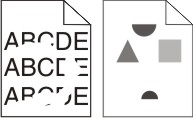Print is too light
These are possible solutions. Try one or more of the following:
Recalibrate the printer
Perform Color Adjust from the printer control panel Quality menu.
Check the darkness, brightness, and contrast settings
The Toner Darkness setting is too light, the RGB Brightness setting is too light, or the RGB Contrast setting is too low.
Change these settings from the printer control panel Quality menu.
For Windows users, change these settings from Print Properties.
For Macintosh users, change these settings from the Print dialog and pop-up menus.
The paper may have absorbed moisture due to high humidity
Load paper from a fresh package.
Check the paper
Avoid textured paper with rough finishes.
Check the paper type and weight settings
Make sure the paper type and weight settings match the paper loaded in the tray:
From the printer control panel Paper menu, check the Paper Type and Paper Weight settings.
Before sending the job to print, specify the correct type setting:
For Windows users, specify the type from Print Properties.
For Macintosh users, specify the type from the Print dialog.
Color Saver may be set to On
Turn Color Saver off in the printer control panel Quality menu.
The toner may be low
Replace the toner cartridge.
The toner cartridge may be worn or defective
Replace the toner cartridge.
 and the right arrow button while turning the printer on.
and the right arrow button while turning the printer on. appears, and then press
appears, and then press  .
. appears, and then press
appears, and then press  .
.


 .
.













